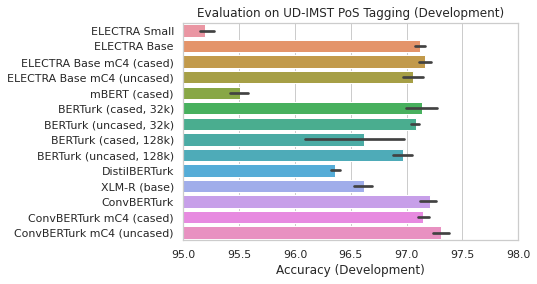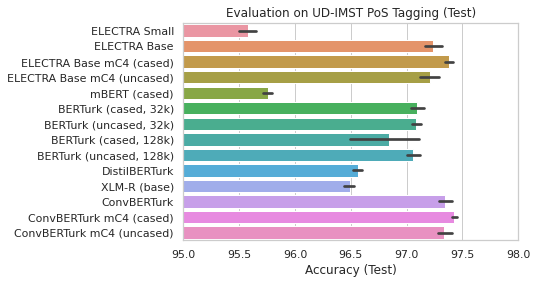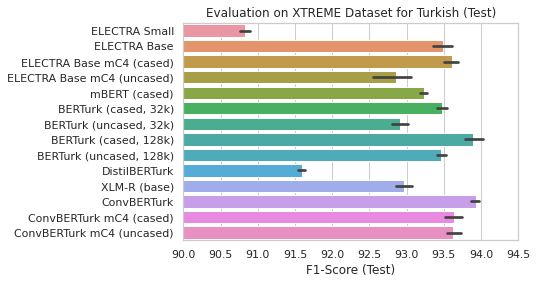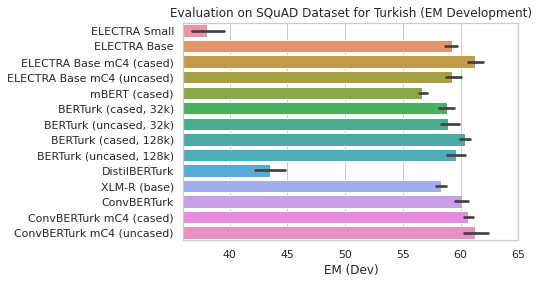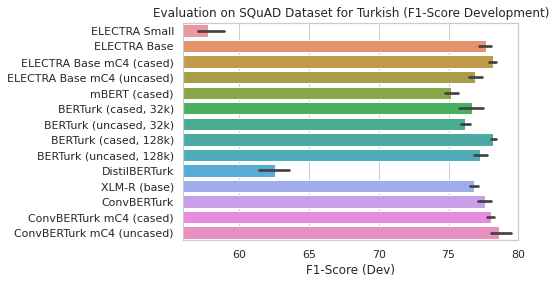We present community-driven BERT, DistilBERT, ELECTRA and ConvBERT models for Turkish 🎉
Some datasets used for pretraining and evaluation are contributed from the awesome Turkish NLP community, as well as the decision for the BERT model name: BERTurk.
Logo is provided by Merve Noyan.
- 23.09.2021: Release of uncased ELECTRA and ConvBERT models and cased ELECTRA model, all trained on mC4 corpus.
- 24.06.2021: Release of new ELECTRA model, trained on Turkish part of mC4 dataset. Repository got new awesome logo from Merve Noyan.
- 16.03.2021: Release of ConvBERTurk model and more evaluations on different downstream tasks.
- 12.05.2020: Release of ELECTRA (small and base) models, see here.
- 25.03.2020: Release of BERTurk uncased model and BERTurk models with larger vocab size (128k, cased and uncased).
- 11.03.2020: Release of the cased distilled BERTurk model: DistilBERTurk. Available on the Hugging Face model hub
- 17.02.2020: Release of the cased BERTurk model. Available on the Hugging Face model hub
- 10.02.2020: Training corpus update, new TensorBoard links, new results for cased model.
- 02.02.2020: Initial version of this repo.
The current version of the model is trained on a filtered and sentence segmented version of the Turkish OSCAR corpus, a recent Wikipedia dump, various OPUS corpora and a special corpus provided by Kemal Oflazer.
The final training corpus has a size of 35GB and 4,404,976,662 tokens.
Thanks to Google's TensorFlow Research Cloud (TFRC) we can train both cased and uncased models on a TPU v3-8. You can find the TensorBoard outputs for the training here:
We also provide cased and uncased models that aŕe using a larger vocab size (128k instead of 32k).
A detailed cheatsheet of how the models were trained, can be found here.
We've also trained an ELECTRA (cased) model on the recently released Turkish part of the multiligual C4 (mC4) corpus from the AI2 team.
After filtering documents with a broken encoding, the training corpus has a size of 242GB resulting in 31,240,963,926 tokens.
We used the original 32k vocab (instead of creating a new one).
Here's an overview of all available models, incl. their training corpus size:
| Model name | Model hub link | Pre-training corpus size |
|---|---|---|
| ELECTRA Small (cased) | here | 35GB |
| ELECTRA Base (cased) | here | 35GB |
| ELECTRA Base mC4 (cased) | here | 242GB |
| ELECTRA Base mC4 (uncased) | here | 242GB |
| BERTurk (cased, 32k) | here | 35GB |
| BERTurk (uncased, 32k) | here | 35GB |
| BERTurk (cased, 128k) | here | 35GB |
| BERTurk (uncased, 128k) | here | 35GB |
| DistilBERTurk (cased) | here | 35GB |
| ConvBERTurk (cased) | here | 35GB |
| ConvBERTurk mC4 (cased) | here | 242GB |
| ConvBERTurk mC4 (uncased) | here | 242GB |
The distilled version of a cased model, so called DistilBERTurk, was trained on 7GB of the original training data, using the cased version of BERTurk as teacher model.
DistilBERTurk was trained with the official Hugging Face implementation from here.
The cased model was trained for 5 days on 4 RTX 2080 TI.
More details about distillation can be found in the "DistilBERT, a distilled version of BERT: smaller, faster, cheaper and lighter" paper by Sanh et al. (2019).
In addition to the BERTurk models, we also trained ELECTRA small and base models. A detailed overview can be found in the ELECTRA section.
In addition to the BERT and ELECTRA based models, we also trained a ConvBERT model. The ConvBERT architecture is presented in the "ConvBERT: Improving BERT with Span-based Dynamic Convolution" paper.
We follow a different training procedure: instead of using a two-phase approach, that pre-trains the model for 90% with 128 sequence length and 10% with 512 sequence length, we pre-train the model with 512 sequence length for 1M steps on a v3-32 TPU.
More details about the pre-training can be found here.
In addition to the ELECTRA base model, we also trained an ELECTRA model on the Turkish part of the mC4 corpus. We use a sequence length of 512 over the full training time and train the model for 1M steps on a v3-32 TPU.
For evaluation we use latest Flair 0.8.1 version with a fine-tuning approach for PoS Tagging and NER downstream tasks. In order to evaluate models on a Turkish question answering dataset, we use the question answering example from the awesome 🤗 Transformers library.
We use the following hyperparameters for training PoS and NER models with Flair:
| Parameter | Value |
|---|---|
batch_size |
16 |
learning_rate |
5e-5 |
num_epochs |
10 |
For the question answering task, we use the same hyperparameters as used in the "How Good Is Your Tokenizer?" paper.
The script train_flert_model.py in this repository can be used to fine-tune models on PoS Tagging an NER datasets.
We pre-train models with 5 different seeds and reported averaged accuracy (PoS tagging), F1-score (NER) or EM/F1 (Question answering).
For some downstream tasks, we perform "Almost Stochastic Order" tests as proposed in the "Deep Dominance - How to Properly Compare Deep Neural Models" paper. The heatmap figures are heavily inspired by the "CharacterBERT" paper.
We use two different PoS Tagging datasets for Turkish from the Universal Dependencies project:
We use the dev branch for training/dev/test splits.
| Model | Development Accuracy | Test Accuracy |
|---|---|---|
| BERTurk (cased, 128k) | 96.614 ± 0.58 | 96.846 ± 0.42 |
| BERTurk (cased, 32k) | 97.138 ± 0.18 | 97.096 ± 0.07 |
| BERTurk (uncased, 128k) | 96.964 ± 0.11 | 97.060 ± 0.07 |
| BERTurk (uncased, 32k) | 97.080 ± 0.05 | 97.088 ± 0.05 |
| ConvBERTurk | 97.208 ± 0.10 | 97.346 ± 0.07 |
| ConvBERTurk mC4 (cased) | 97.148 ± 0.07 | 97.426 ± 0.03 |
| ConvBERTurk mC4 (uncased) | 97.308 ± 0.09 | 97.338 ± 0.08 |
| DistilBERTurk | 96.362 ± 0.05 | 96.560 ± 0.05 |
| ELECTRA Base | 97.122 ± 0.06 | 97.232 ± 0.09 |
| ELECTRA Base mC4 (cased) | 97.166 ± 0.07 | 97.380 ± 0.05 |
| ELECTRA Base mC4 (uncased) | 97.058 ± 0.12 | 97.210 ± 0.11 |
| ELECTRA Small | 95.196 ± 0.09 | 95.578 ± 0.10 |
| XLM-R (base) | 96.618 ± 0.10 | 96.492 ± 0.06 |
| mBERT (cased) | 95.504 ± 0.10 | 95.754 ± 0.05 |
Almost Stochastic Order tests (using the default alpha of 0.05) on test set:
| Model | Development Accuracy | Test Accuracy |
|---|---|---|
| BERTurk (cased, 128k) | 90.828 ± 0.71 | 91.016 ± 0.60 |
| BERTurk (cased, 32k) | 91.460 ± 0.10 | 91.490 ± 0.10 |
| BERTurk (uncased, 128k) | 91.010 ± 0.15 | 91.286 ± 0.09 |
| BERTurk (uncased, 32k) | 91.322 ± 0.19 | 91.544 ± 0.09 |
| ConvBERTurk | 91.250 ± 0.14 | 91.524 ± 0.07 |
| ConvBERTurk mC4 (cased) | 91.552 ± 0.10 | 91.724 ± 0.07 |
| ConvBERTurk mC4 (uncased) | 91.202 ± 0.16 | 91.484 ± 0.12 |
| DistilBERTurk | 91.166 ± 0.10 | 91.044 ± 0.09 |
| ELECTRA Base | 91.354 ± 0.04 | 91.534 ± 0.11 |
| ELECTRA Base mC4 (cased) | 91.402 ± 0.14 | 91.746 ± 0.11 |
| ELECTRA Base mC4 (uncased) | 91.100 ± 0.13 | 91.178 ± 0.15 |
| ELECTRA Small | 91.020 ± 0.11 | 90.850 ± 0.12 |
| XLM-R (base) | 91.828 ± 0.08 | 91.862 ± 0.16 |
| mBERT (cased) | 91.286 ± 0.07 | 91.492 ± 0.11 |
We use the Turkish dataset split from the XTREME Benchmark.
These training/dev/split were introduced in the "Massively Multilingual Transfer for NER" paper and are based on the famous WikiANN dataset, that is presentend in the "Cross-lingual Name Tagging and Linking for 282 Languages" paper.
| Model | Development F1-score | Test F1-score |
|---|---|---|
| BERTurk (cased, 128k) | 93.796 ± 0.07 | 93.8960 ± 0.16 |
| BERTurk (cased, 32k) | 93.470 ± 0.11 | 93.4706 ± 0.09 |
| BERTurk (uncased, 128k) | 93.604 ± 0.12 | 93.4686 ± 0.08 |
| BERTurk (uncased, 32k) | 92.962 ± 0.08 | 92.9086 ± 0.14 |
| ConvBERTurk | 93.822 ± 0.14 | 93.9286 ± 0.07 |
| ConvBERTurk mC4 (cased) | 93.778 ± 0.15 | 93.6426 ± 0.15 |
| ConvBERTurk mC4 (uncased) | 93.586 ± 0.07 | 93.6206 ± 0.13 |
| DistilBERTurk | 92.012 ± 0.09 | 91.5966 ± 0.06 |
| ELECTRA Base | 93.572 ± 0.08 | 93.4826 ± 0.17 |
| ELECTRA Base mC4 (cased) | 93.600 ± 0.13 | 93.6066 ± 0.12 |
| ELECTRA Base mC4 (uncased) | 93.092 ± 0.15 | 92.8606 ± 0.36 |
| ELECTRA Small | 91.278 ± 0.08 | 90.8306 ± 0.09 |
| XLM-R (base) | 92.986 ± 0.05 | 92.9586 ± 0.14 |
| mBERT (cased) | 93.308 ± 0.09 | 93.2306 ± 0.07 |
We use the Turkish Question Answering dataset from this website and report EM and F1-Score on the development set (as reported from Transformers).
| Model | Development EM | Development F1-score |
|---|---|---|
| BERTurk (cased, 128k) | 60.38 ± 0.61 | 78.21 ± 0.24 |
| BERTurk (cased, 32k) | 58.79 ± 0.81 | 76.70 ± 1.04 |
| BERTurk (uncased, 128k) | 59.60 ± 1.02 | 77.24 ± 0.59 |
| BERTurk (uncased, 32k) | 58.92 ± 1.06 | 76.22 ± 0.42 |
| ConvBERTurk | 60.11 ± 0.72 | 77.64 ± 0.59 |
| ConvBERTurk mC4 (cased) | 60.65 ± 0.51 | 78.06 ± 0.34 |
| ConvBERTurk mC4 (uncased) | 61.28 ± 1.27 | 78.63 ± 0.96 |
| DistilBERTurk | 43.52 ± 1.63 | 62.56 ± 1.44 |
| ELECTRA Base | 59.24 ± 0.70 | 77.70 ± 0.51 |
| ELECTRA Base mC4 (cased) | 61.28 ± 0.94 | 78.17 ± 0.33 |
| ELECTRA Base mC4 (uncased) | 59.28 ± 0.87 | 76.88 ± 0.61 |
| ELECTRA Small | 38.05 ± 1.83 | 57.79 ± 1.22 |
| XLM-R (base) | 58.27 ± 0.53 | 76.80 ± 0.39 |
| mBERT (cased) | 56.70 ± 0.43 | 75.20 ± 0.61 |
All trained models can be used from the DBMDZ Hugging Face model hub page using their model name. The following models are available:
- BERTurk models with 32k vocabulary:
dbmdz/bert-base-turkish-casedanddbmdz/bert-base-turkish-uncased - BERTurk models with 128k vocabulary:
dbmdz/bert-base-turkish-128k-casedanddbmdz/bert-base-turkish-128k-uncased - ELECTRA small and base cased models (discriminator):
dbmdz/electra-small-turkish-cased-discriminatoranddbmdz/electra-base-turkish-cased-discriminator - ELECTRA base cased and uncased models, trained on Turkish part of mC4 corpus (discriminator):
dbmdz/electra-small-turkish-mc4-cased-discriminatoranddbmdz/electra-small-turkish-mc4-uncased-discriminator - ConvBERTurk model with 32k vocabulary:
dbmdz/convbert-base-turkish-cased - ConvBERTurk base cased and uncased models, trained on Turkish part of mC4 corpus:
dbmdz/convbert-base-turkish-mc4-casedanddbmdz/convbert-base-turkish-mc4-uncased
Example usage with 🤗/Transformers:
tokenizer = AutoTokenizer.from_pretrained("dbmdz/bert-base-turkish-cased")
model = AutoModel.from_pretrained("dbmdz/bert-base-turkish-cased")This loads the BERTurk cased model. The recently introduced ELECTRA base model can be loaded with:
tokenizer = AutoTokenizer.from_pretrained("dbmdz/electra-base-turkish-cased-discriminator")
model = AutoModelWithLMHead.from_pretrained("dbmdz/electra-base-turkish-cased-discriminator")You can use the following BibTeX entry for citation:
@software{stefan_schweter_2020_3770924,
author = {Stefan Schweter},
title = {BERTurk - BERT models for Turkish},
month = apr,
year = 2020,
publisher = {Zenodo},
version = {1.0.0},
doi = {10.5281/zenodo.3770924},
url = {https://doi.org/10.5281/zenodo.3770924}
}Thanks to Kemal Oflazer for providing us additional large corpora for Turkish. Many thanks to Reyyan Yeniterzi for providing us the Turkish NER dataset for evaluation.
We would like to thank Merve Noyan for the awesome logo!
Research supported with Cloud TPUs from Google's TensorFlow Research Cloud (TFRC). Thanks for providing access to the TFRC ❤️

